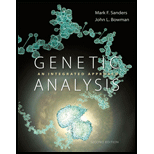
Concept explainers
Reciprocal crosses of experimental animals or plants sometimes give different results in the
To analyze:
Reciprocal crosses of trial animals or plants, sometime give dissimilar results in
Introduction:
The reciprocal cross is a duo of crosses between a male of one strain and a female of other and vice versa. It is used to investigate the role of parental sex on a given inheritance pattern. It is used to identify whether the allele is present on an autosome or on the sex-chromosome.
Explanation of Solution
In the reciprocal cross, the parental genotype is reversed to test the role of the paternal sex on the inheritance pattern. If the F
The other than autosome allele can either be inherited from the sex chromosome or by parental inheritance. In parental inheritance, two possible explanations for the change in result would be-
Homoplasmy - homoplastic cells have organelles with the same genotype.
Heteroplasmy - Heteroplasmic cells contain a mixture of the allele.
The reciprocal cross shows a different result in F
Want to see more full solutions like this?
Chapter 19 Solutions
Genetic Analysis: An Integrated Approach (2nd Edition)
Additional Science Textbook Solutions
Campbell Essential Biology (6th Edition) - standalone book
Campbell Essential Biology with Physiology (6th Edition)
Campbell Biology in Focus (2nd Edition)
Concepts of Genetics (11th Edition)
Essentials of Genetics (9th Edition) - Standalone book
Brock Biology of Microorganisms (15th Edition)
- Individuals of genotype AaBb were mated to individuals of genotype aabb. One thousand offspring were counted, with the following results: 474 Aabb, 480 aaBb, 20 AaBb, and 26 aabb. What type of cross is it? Are these loci linked? What are the two parental classes and the two recombinant classes of offspring? What is the percentage of recombination between these two loci? How many map units apart are they?arrow_forwardGiven the karyotype shown at right, is this a male or a female? Normal or abnormal? What would the phenotype of this individual be?arrow_forwardNicotiana glutinosa (2n = 24) and N. tabacum (2n = 48) are two closely related plant species that can be intercrossed, but the F1 hybrid plants that result are usually sterile. In 1925, Roy Clausen and Thomas Goodspeed crossed N. glutinosa and N. tabacum, and obtained one fertile F1 plant (R. E. Clausen and T. H. Goodspeed. 1925. Genetics 10:278–284). They were able to self-pollinate the flowers of this plant to produce an F2 generation. Surprisingly, the F2 plants were fully fertile and produced viable seed. When Clausen and Goodspeed examined the chromosomes of the F2 plants, they observed 36 pairs of chromosomes in metaphase I and 36 individual chromosomes in metaphase II. Explain the origin of the F2 plants obtained by Clausen and Goodspeed and the numbers of chromosomes observedarrow_forward
- To determine the recombination frequency between body color and wing genes in flies, you perform several crosses where you cross an F1 having red body and smooth wings with a yellow-bodied, crinkle-winged fly. You get the following results. What is the distance between the genes for body color and wing surface in map units?arrow_forwardWhat will be the phenotypic ratio for a heterozygous cross between Pp and Pp?arrow_forwardWhen true-breeding mice with brown fur and short tails (BBtt)were crossed to true-breeding mice with white fur and long tails(bbTT), all of the F1 offspring had brown fur and long tails. TheF1 offspring were crossed to mice with white fur and short tails.What are the possible phenotypes of the F2 offspring? Which F2offspring are recombinant, and which are nonrecombinant? Whatare the ratios of phenotypes of the F2 offspring if independentassortment is taking place? How are the ratios affected by linkage?arrow_forward
- PLEASE SHOW THE CROSSES USING PROBABILITY RULE In guinea pigs, rough coat (R) is dominant over smooth (r), and black coat (B) is dominant over white (b). If a pure-breeding rough, black animal is crossed with a smooth white one: What will be the appearance of the F1 progeny? The F2?arrow_forwardThe A locus and the D locus are so tightly linked that norecombination is ever observed between them. If Ad/Ad is crossed with aD/aD and the F1 is intercrossed,what phenotypes will be seen in the F2 and in whatproportions?arrow_forwardWhat two essential criteria must be met in order to execute a successful mapping cross?arrow_forward
- Why is a 50 percent recovery of single-crossover products theupper limit, even when crossing over always occurs between twolinked genes ?arrow_forward. A snapdragon plant that bred true for white petals wascrossed with a plant that bred true for purple petals, andall the F1 had white petals. The F1 was selfed. Among theF2, three phenotypes were observed in the followingnumbers:white 240solid purple 61spotted purple 19Total 320a. Propose an explanation for these results, showinggenotypes of all generations (make up and explain yoursymbols).b. A white F2 plant was crossed with a solid purple F2plant, and the progeny werewhite 50%solid purple 25%spotted purple 25%What were the genotypes of the F2 plants crossed?arrow_forwardFrom a series of two-point crosses, the following mapdistances were obtained for the syntenic genes A, B,C, and D in peas:B ↔ C 23 m.u.A ↔ C 15 m.u.C ↔ D 14 m.u.A ↔ B 12 m.u.B ↔ D 11 m.u.A ↔ D 1 m.u.Chi-square analysis cannot reject the null hypothesis of no linkage for gene E with any of theother four genes.a. Draw a cross scheme that would allow you todetermine the B ↔ C map distance.b. Diagram the best genetic map that can be assembled from this data set.c. Explain any inconsistencies or unknown features inyour map.d. What additional experiments would allow you toresolve these inconsistencies or ambiguities?arrow_forward
 Biology (MindTap Course List)BiologyISBN:9781337392938Author:Eldra Solomon, Charles Martin, Diana W. Martin, Linda R. BergPublisher:Cengage Learning
Biology (MindTap Course List)BiologyISBN:9781337392938Author:Eldra Solomon, Charles Martin, Diana W. Martin, Linda R. BergPublisher:Cengage Learning Concepts of BiologyBiologyISBN:9781938168116Author:Samantha Fowler, Rebecca Roush, James WisePublisher:OpenStax College
Concepts of BiologyBiologyISBN:9781938168116Author:Samantha Fowler, Rebecca Roush, James WisePublisher:OpenStax College Human Heredity: Principles and Issues (MindTap Co...BiologyISBN:9781305251052Author:Michael CummingsPublisher:Cengage Learning
Human Heredity: Principles and Issues (MindTap Co...BiologyISBN:9781305251052Author:Michael CummingsPublisher:Cengage Learning


